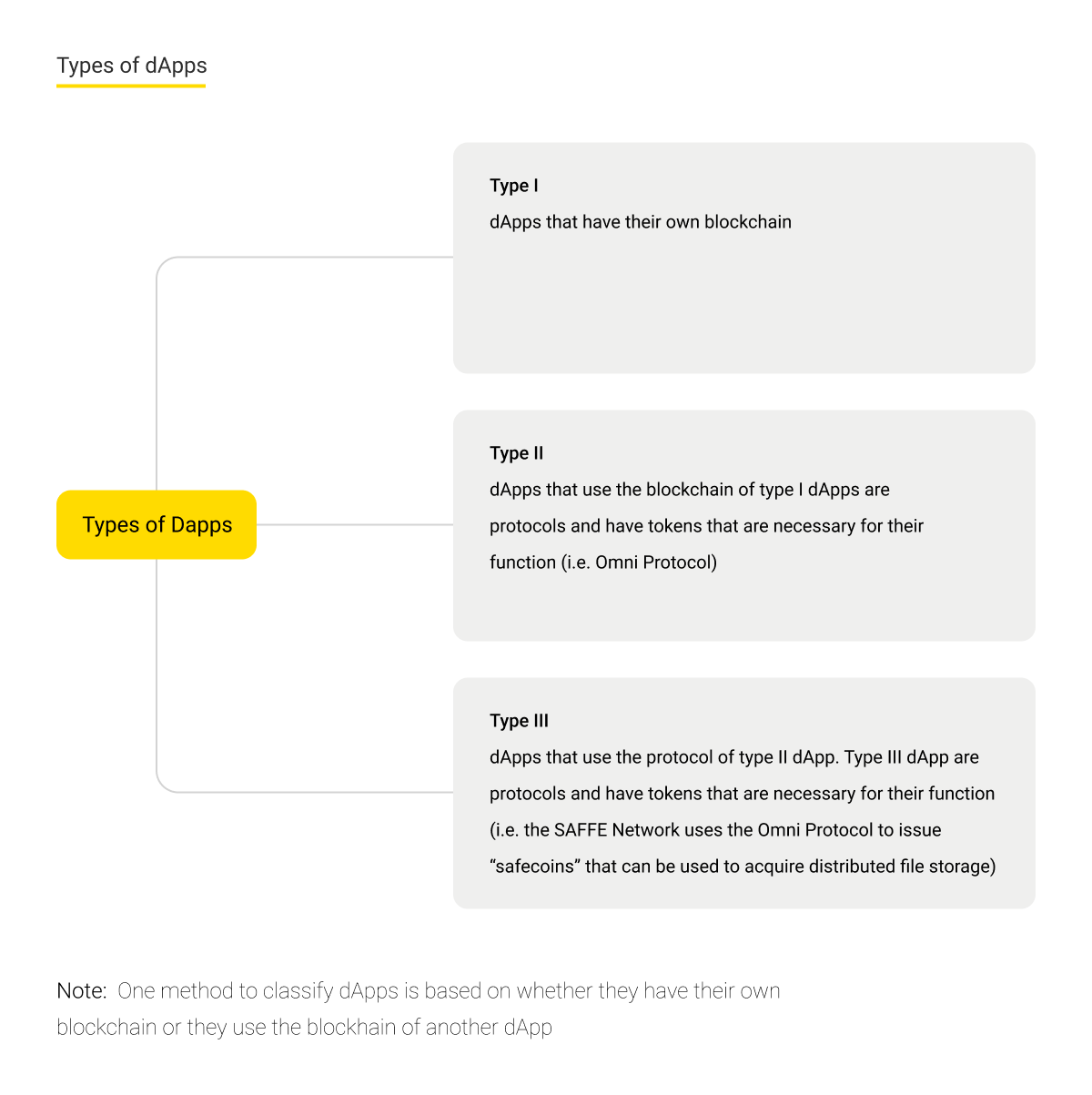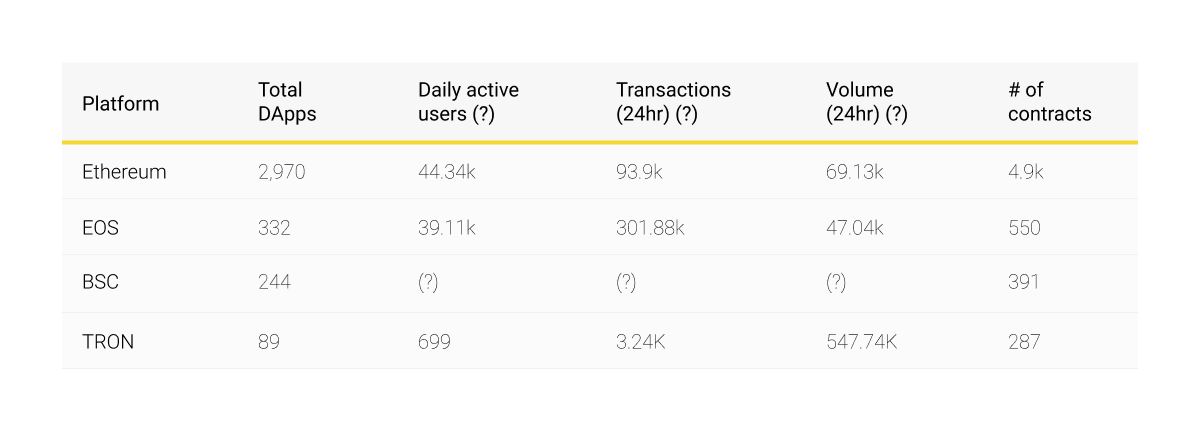Despite the recent downward trend some people are calling ‘crypto winter,’ such words as ‘decentralized app’ and ‘Blockchain’ are being mentioned more and more often to describe the Web3-based tech world of tomorrow. As a custom software development company running a top-notch team for dApp development, we at Andersen are closely monitoring all the most important trends and developments. According to DappRadar, in 2021, the amount of daily active wallets connected to decentralized apps hosted by one of the 30 popular Blockchain networks they were tracking, hit 2.7 million. The number of connections was 592% more than in 2020. Therefore, it is time to elaborate, with dApp development company Andersen, on what dApps are all about, and why they are attracting more and more people.
What is a decentralized app or, alternatively, dApp?
Centralized apps are owned and managed by a single company. As such, they run off a single server or, alternatively, server clusters. In practice, when someone downloads a copy of an app, it must send and receive data from its server to function. If the server experiences tech issues and crashes, the app ceases to function until the issue is resolved.
Decentralized apps, on the other hand, run on a Blockchain network. Instead of downloading an app, the end-user pays a developer a given amount of crypto assets to download a ‘smart contract.’ Basically, this contract is nothing more than just source code. That code, in turn, creates an entirely fresh copy of the app on the end-user’s device. That is how a new block is generated.
In a nutshell, dApps are run on P2P Blockchain networks, instead of centralized servers.
As for the types of dApps, the following classifications can be made.
First, by their basis:
-
Type 1 uses its own ‘proprietary’ Blockchain protocol, e.g. BTC.
-
Type 2 is, essentially, a second additional layer that uses Type 1 as its basis. The purpose of the second layer is to boost the efficiency of the first one. A classical example of this combination is the way the Lightning Network works with the Bitcoin network. By being added to BTC, the Lightning Network increases the speed of BTC transactions.
-
Type 3 uses a Type 2 app protocol. The SAFE (Secure Access for All) network is an example of a Type 3 dApp. It is a decentralized storage and communication network that replaces data centers and servers with additional computing resources for its end-users. As an offline data network, it makes it possible for end-users to build censorship-resistant websites and apps. To achieve this goal, it uses the Omni Protocol (BTC-based Type 2 layer) to issue SafeCoins, which are, in turn, used to enable its functionalities.

Second, by their domains and purpose. For instance, State of the dApps says there are currently as many as 4,073 dApps in existence (some of them are not in use and are not being improved, but still, they technically exist). According to them, the most popular classes in the dApp development domain include, in terms of daily transactions:
- Finance;
- Exchanges;
- Wallets;
- Security;
- Transaction speed;
- Games;
- Development;
- Gambling;
- Social;
- Storage.
Reasons to build decentralized Blockchain-based apps
Hence, one can summarize the advantages offered by dApps this way:
- Freedom from censorship, especially that exercised by a single provider.
- Better protection of privacy as it is secured by the decentralized essence of the Blockchain technology. Namely, users do not have to entrust their sensitive info to anyone to make use of dApp capabilities.
- Transparency, with all records being visible.
- More flexible dApp development patterns inspired by the dApp community and their open-source nature. Ideally, they must all be universally accessible for anyone to check, alter, and improve. In reality, some dApps are semi-closed or even fully closed. However, the more open a dApp is, the more users it wins.
- The rapid transaction speed is a matter of enormous importance for Blockchain users.
In addition, transactions between dApp users are enabled by smart contracts, which is an obvious advantage.
Popular Blockchain protocols
While assessing the pros and cons of various Blockchains for dApp development, the first step taken by most dApp development companies would be to examine their rivals and peers. The industry landscape, according to State of the dApps, looks as follows:
- ETH serves as a basis for 2,970 decentralized apps;
- EOS is responsible for 332 dApps;
- BSC, aka Binance, is ‘home’ to 244 projects;
- Finally, TRON accounts for 89.

Why did their creators choose these Blockchains for their dApp development initiatives? There are several considerations almost every dApp development company takes into account.
How to choose a Blockchain for dApp development
Not so long ago, Vitalik Buterin, the father of ETH, put forward the so-called ‘Blockchain trilemma.’ Namely, a dApp development team has to prioritize one of the following three dimensions:
- Decentralization;
- Security;
- Scalability.
In addition, many teams also assess such factors as existing Blockchain communities, speed, and funding prospects. However, the aforementioned dimensions are the crucial ones. What you choose to prioritize depends on your goals. Below, we will cite some facts about the top four Blockchains for dApp development companies.
ETH: pros and cons
As you have already seen, Ethereum is an industry standard for dApp development, both popular and widely known. At the same time, it is still not an answer to the Blockchain trilemma. It is decentralized, not 100% secure, and slow. Its advantages are:
- An extended set of development tools, available models, and easily deployable functionalities;
- A significant community that is ready to fuel the network;
- Reliability.
Its disadvantages are:
- Slow transactions;
- Higher deployment costs;
- Reliance on the Proof of Work consensus, which negatively affects operational processes.
EOS: pros and cons
EOS is secure and extremely fast. Its advantages are:
- A high transaction speed;
- Almost no transaction fees, except for the requirement to stake some assets to deploy a contract;
- Voting opportunities make it possible to engage users to a greater extent;
- Opportunity to win smart contracts.
Its disadvantages are:
- Even seasoned Blockchain developers might experience difficulties while dealing with validation and staking issues;
- Your decentralized app may end up being centralized due to an insufficient circle of validators.
BSC: pros and cons
The Binance chain is centralized; however, it offers an amazing transaction speed. As for security, opinions differ. It is secure, but still, there are sceptics stating that its centralization is a matter of concern. Its advantages are:
- Low transaction costs;
- As Binance is not as congested as ETH, due to the fact that it is less popular, its transaction speed is more impressive.
Its disadvantages are:
- Binance cannot boast as many validators as ETH. Hence, dApps built on it are not as decentralized;
- On top of that, fewer token owners make it harder to promote a dApp.
TRON: pros and cons
TRON is viewed by the crypto community as a centralized asset, since the community exercises little influence on blocks and transactions. On the other hand, it is incredibly fast and almost invincible. Its advantages are:
- Great speed and almost unprecedented number of transactions;
- Affordable transaction fees;
- Scalability and overall transparency.
Its disadvantages are:
- As you might have already guessed, in the light of the Blockchain trilemma, TRON is overcentralized;
- Lack of transparency as it is still not clear who controls the assets.
Conclusion
Selecting the optimal Blockchain basis for your dApp development initiative is an important prerequisite for your eventual results. It is only you who knows the ideal balance between security, scalability, decentralization, community size, etc. for your unique purposes. If you find it hard to make the ultimate decision, contact Andersen, one of most reliable dApp development companies available in the Web3 market. Our Blockchain experts will help you pick the right option and engineer your decentralized apps. Contact us to launch a discussion!
Book a free IT consultation
What happens next?
An expert contacts you after having analyzed your requirements;
If needed, we sign an NDA to ensure the highest privacy level;
We submit a comprehensive project proposal with estimates, timelines, CVs, etc.
Customers who trust us



